You don’t need any fancy gym machines to get a sculpted back. All you need is a set of dumbbells, 20 minutes, and some motivation to get the same results.
If your fitness goal is to build a bigger and stronger back, doing back exercises with dumbbells is a highly effective option. Even if you don’t have a lot of time, these workouts will get the job done in less than 20 minutes.
Dumbbell back workouts require more balance than barbells or machines and a greater range of movement (ROM), which helps increase muscle fiber recruitment. They also allow unilateral training (training one limb at a time), increase core stability, and improve muscular imbalances.
This blog describes the 10 best dumbbell exercises for the back muscles, including the latissimus dorsi (lat), teres major, rhomboids, trapezius, and deep spinal erectors.
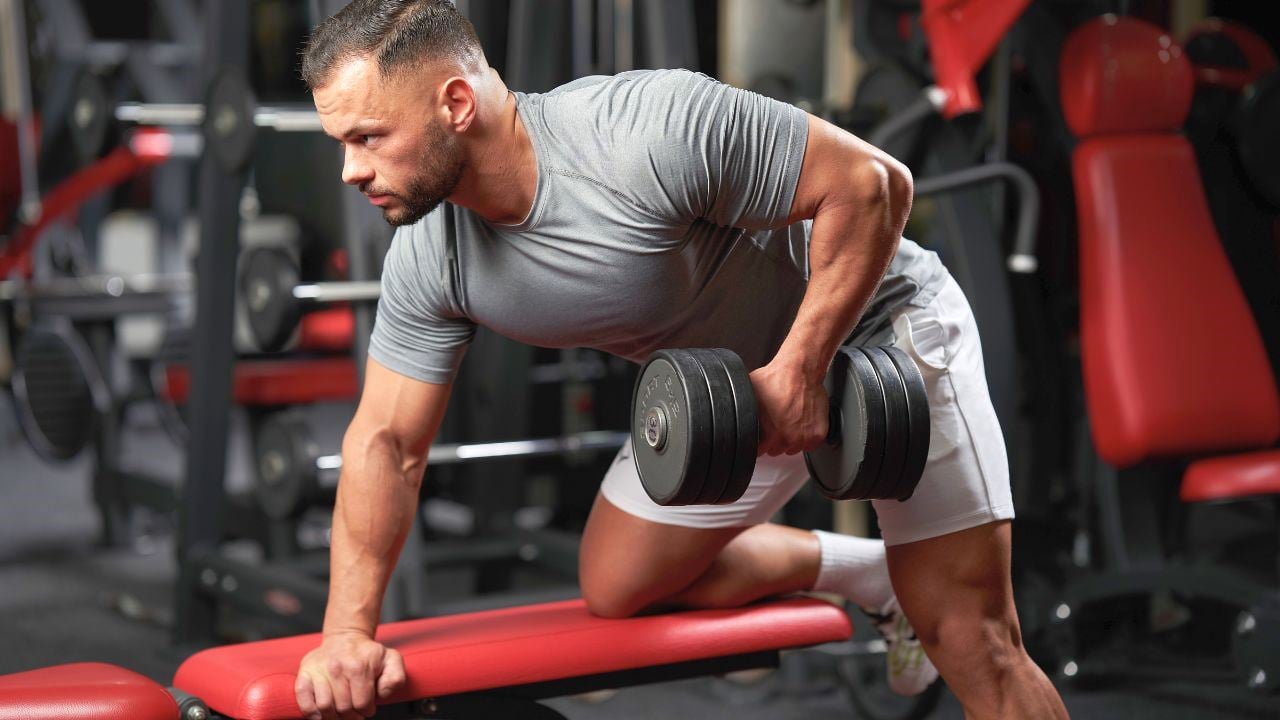
- Back Muscles (Anatomy)
- 10 Best Dumbbell Exercises For Back
- 1. One-Arm Dumbbell Row
- 2. Dumbbell Deadlift
- 3. Dumbbell Shrug
- 4. Dumbbell Upright Row
- 5. Dumbbell Bent Over Row
- 6. Incline Dumbbell Row
- 7. Renegade Row
- 8. Dumbbell Pullover
- 9. Side-Lying Rear Fly
- 10. Bent Over Rear Delt Fly
- Dumbbell Back Workout Routines (With Tips & Techniques)
- Weekly Training Sets For Back
- Optimizing Reps and Weight for Muscle Goals
- Beginner Dumbbell Back Workout Routine
- Intermediate Back Workout
- Advanced Back Workout
- Complete the Back Workout With a Dumbbell
- FAQ
- What Dumbbell Exercises Work The Back?
- Is Train Back With Dumbbell Is Effective
- How do you use dumbbells to work your mid back?
- How do you use dumbbells to work your lower back?
- Conclusion
Back Muscles (Anatomy)
The back muscles are a complex group of muscles that work together to provide stability, movement, and support to the spine and upper body.
The back consists of several layers of muscle stacked like a sandwich. The muscles are subdivided into three categories.
- The upper back comprises a large, triangular-shaped muscle called the trapezius.
- The middle back consists of the latissimus dorsi, Rhomboids.
- The lower back is made up of the erector spine muscles.

10 Best Dumbbell Exercises For Back
Dumbbell back exercises target the upper and lower lats and lower back muscles. These exercises offer a good mix of accessibility and challenge.
Here are the 10 best dumbbell back workouts for building a massive back.
1. One-Arm Dumbbell Row
If you’re looking for straightforward dumbbell back exercises to add to your routine, the One-arm dumbbell row is a great staple exercise to get you started.
It is an excellent full-range exercise for building the lat muscles. It allows you to work on each side independently, thereby providing better muscle isolation and a longer range of motion.
It’s an excellent alternative to barbell rows. This exercise involves using a heavy dumbbell with your body supported by a bench.
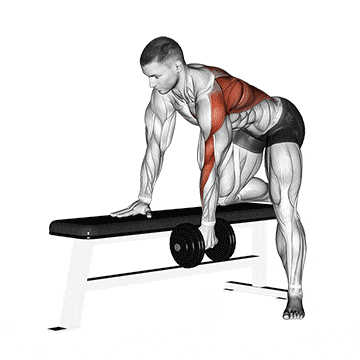
How To Do
- Pick up a dumbbell with the left hand, palm facing in.
- Rest the opposite hand and knee on a bench.
- Important point: Keep your spine straight and just parallel to the floor.
- Pull the dumbbell upward with your torso and raise your elbow as high as possible.
- Slowly lower the dumbbell as low as possible, feeling a good lats spread.
- Repeat on the other side.
Tips
- Keep motion under strict control for better isolation.
- It is important to avoid hunchback bending, as it can lead to injury.
2. Dumbbell Deadlift
The deadlift is the King of all exercises, and It is a powerful exercise designed to build an overall physique that uses more muscles than any other exercise.
It is the best exercise for strengthening the posterior chain muscles, which include the back, erector spine, glutes, and hamstrings.
You can do the deadlift with either a barbell or a set of dumbbells. One of the biggest advantages of using dumbbells for deadlifts is that you can work with a wider range of motion than with barbell deadlifts.
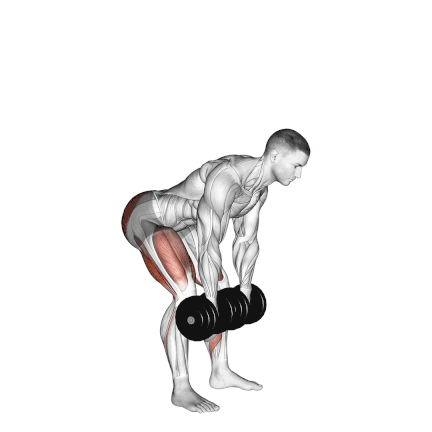
How To Do
- Place a dumbbell in front of you. Grab the dumbbells with each of your hands.
- Remember to keep your back as straight as possible and contract your back and hamstrings.
- Raise the dumbbell from the ground using your hamstrings and glutes.
- Raise it to the point where your body is erect. Do not hyperextend your body as the weight shifts to the lumbar spine.
- In this position, it is recommended to maintain a slight bent on your knees, a straight back, and a forward-facing head.
- Hold the dumbbell for a moment at the top of the lift.
- Now, lower the dumbbell slowly and steadily by bending at the hips and then at the knees.
- Let the weight almost touch the ground briefly before you begin the next rep.
Tips
- If performed incorrectly, the deadlift can cause more harm than good. Keep the back straight at all costs.
- The lower back muscles take a long time to recuperate; therefore, heavy deadlifts should only be done once a week.
- Go with the full range of motion and keep the form correct.
- Avoid jerky movements and keep motion controlled.
3. Dumbbell Shrug
The dumbbell shrug exercise is another great exercise for your dumbbell back workout, it is one of the best exercises to build bigger, stronger trapezius, upper back, and neck muscles.
This exercise can make your traps bigger, which is helpful when doing back poses. Traps are a stubborn muscle group for many so that you can train them fairly frequently during the week.
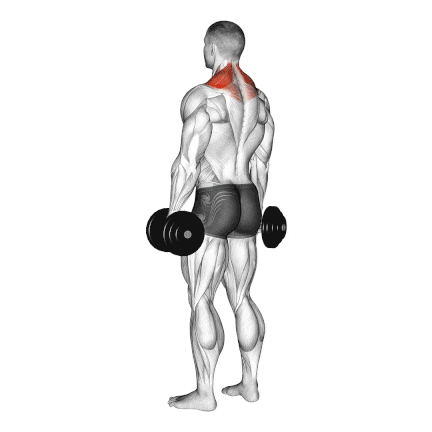
How To Do
- Stand with your feet shoulder-width apart.
- Hold a dumbbell in each hand with your arms extended by your sides.
- Keep your shoulders relaxed and your core engaged.
- Inhale and lift your shoulders towards your ears, making a shrugging motion.
- Hold the contraction for a second or two, then exhale and lower your shoulders back down to the starting position.
- Repeat the movement for the desired number of repetitions, typically 8-15 reps for 2-3 sets.
Tips
- Try not to move anything but your shoulders.
- Inhale when you lower the weight and exhale when you lift.
- Adding a pause at the top of the movement can help to enhance the mind-muscle connection.
- Don’t jerk or bounce the weight.
Related Post: Shrug Exercise: Benefits, Variations, Muscles Used, Tips
4. Dumbbell Upright Row
The Dumbbell Upright Row exercise is one of the best dumbbell exercises for the back that you can do during your upper body workout.
It is a compound exercise that targets your deltoids (shoulders) and traps (upper back) and biceps. It also activates the forearms for stabilization and support.
Using dumbbells in the upright row can help to increase unilateral muscle development and address any asymmetries and movement imbalances as well.
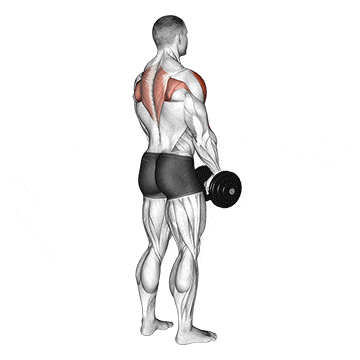
How To Do
- Stand tall with your feet shoulder-width apart.
- Hold a dumbbell in each hand with an overhand grip (palms facing your body).
- Let your arms hang down in front of you, slightly bending your elbows.
- Engage your core and maintain a neutral spine.
- Lift the dumbbell by pulling your elbows up and out to the sides, keeping them higher than your wrists.
- Keep moving until the dumbbells are at chest height or your elbows align with your shoulders.
- Pause for a moment at the top, squeezing your shoulder blades together.
- Then slowly lower the dumbbells back down to the starting position.
- Repeat the desired number of reps and sets.
Tips
- Remember to breathe out when you work hard.
- Keep the dumbbell close to your body.
- Keep a controlled motion and avoid jerky movements.
- You should keep your back straight.
Know More: Upright Row: Muscle Worked, How To Do And Form
5. Dumbbell Bent Over Row
If you are looking to strengthen the upper back with a dumbbell-only workout and add massive muscle to the upper back region, bent-over dumbbell back rows are one of the best options.
It involves pulling the dumbbells towards your torso while maintaining a bent-over position, engaging the back muscles to perform the movement.
- Pulling the dumbbell up higher toward the chest targets the upper latissimus and trapezius.
- Pulling the dumbbell through a lower trajectory to touch the abdomen targets the lower lats.
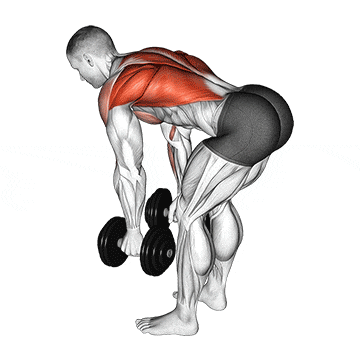
How To Do
- Stand with a narrow stance and hold a dumbbell with a neutral grip in each hand.
- Hinge forward at your hips while keeping your back straight
- Let your arms hang straight down towards the floor, with the dumbbells in front of your knees.
- Pull the dumbbells towards your torso. Try to bring the dumbbells to the level of your ribcage or a little lower.
- Slowly lower the dumbbells back to the starting position.
- Repeat for the desired number of repetitions.
Tips
- Do not use more weight than you can handle. This fatigues your spinal erectors and says goodbye to form.
- Keep movement always under control, without letting gravity take you down faster.
- Avoid rounding your spine or arching your back excessively.
- Keep your elbows close to your body as you lift.
6. Incline Dumbbell Row
If you’re looking for a way to get more creative with your back exercises, why not try an Incline dumbbell row?
The incline dumbbell row also known as chest-supported row, is an ideal row variation to get the best form, prevent mid-row rocking, reduce the risk of injury, and isolate the muscles you want to build.
Keep your chest on the bench throughout the movement, which will eliminate momentum and work the muscles you want.
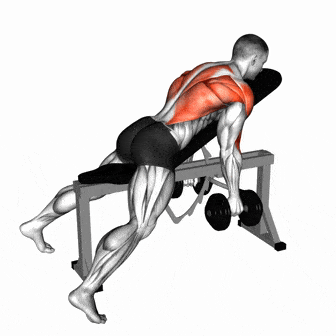
How To Do
- Adjust an incline bench and set it below 45 degrees.
- The bench should support your chest, with your chin above the top.
- Grasp a dumbbell in each hand. Let the dumbbells hang directly below your shoulders.
- Keep your palms facing each other and your elbows close to your body while you do this exercise.
- Pull the weights as high as possible, squeezing your shoulder blades together at the top.
- Hold this position briefly before returning the dumbbells to the starting position.
Tips
- Keep movement always under control, without letting gravity take you down faster.
- As you pull the dumbbells towards your body, don’t hyperextend the thoracic spine by pulling your entire upper torso off the bench.
- Try to pinch your shoulder blades together at the top.
7. Renegade Row
The renegade row is also known as a plank row, almost a variation of the dumbbell row. It is designed to target the upper back. Like a plank, it is designed to target the core.
The renegade row is a multitasking exercise that tones your back and works your core, while also testing your balance and stability.
The ultimate functional strength-training move will give you a massive back.
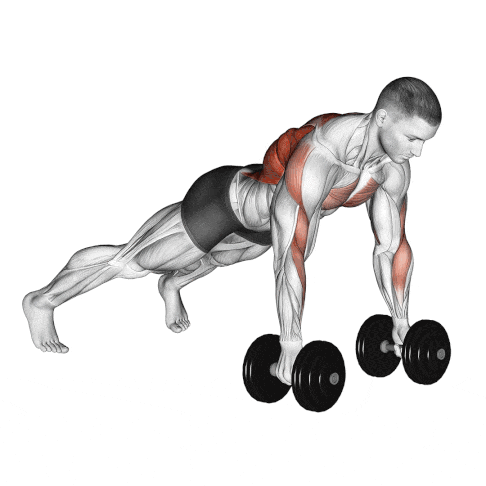
How To Do
- Place two dumbbells on the floor about shoulder-width apart.
- Start in the top of a push-up position with your hands on the weights.
- Pull your right elbow back, raising the dumbbell toward your chest. Keep your right elbow close to your torso, your abs tight, and your hips in one line.
- Hold for one second at the top and return the weight slowly to the starting position to repeat on the other side.
- Complete the desired number of repetitions.
Tips
- Keep your body straight from your shoulders to your ankles as you row the weight.
- Move the weight in a smooth, controlled motion.
- You should do the same number of reps for each side.
8. Dumbbell Pullover
The dumbbell pullover is unique because it works the chest muscles and the latissimus dorsi at once and promotes balanced upper-body strength and muscle development.
It allows you to accomplish a tremendous amount in a single exercise. This dumbbell workout is a must-have addition to your back workout regimen to build a strong and impressive back.

How To Do
- Lie on a flat bench with your upper back and shoulders supported and your feet planted firmly on the ground for stability.
- Hold a dumbbell with both hands directly above your chest, arms straight.
- Ensure you keep a slight bend in your elbows and slowly lower the dumbbell in an arc-like motion over your head and towards the floor.
- Reverse the motion, pulling the dumbbell back over your chest in a controlled manner.
Tips
- Do not lower the dumbbell too far if it causes discomfort or strain in your shoulders or lower back.
9. Side-Lying Rear Fly
When doing a back workout with a dumbbell, you can add plenty of single-arm exercises to correct potential imbalances. The side-lying rear delt fly is an upper back exercise used to target the rear delts and rhomboids.
It is a great unilateral exercise used to target a smaller and often lagging muscle group. Instead of lying on the floor, you can lie on a bench.
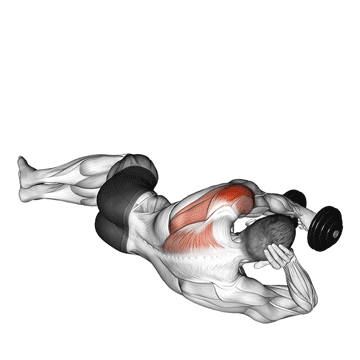
How To Do
- Lie on the floor on your right side, and grasp the dumbbell with your left hand using a neutral grip (palm facing downward).
- Keep your elbow fixed and your body still, and exhale as you raise the dumbbell from the floor until it is almost vertical. Hold for a count of two.
- Inhale as you reverse the movement and lower the dumbbell towards the starting position, stopping before the dumbbell touches the floor.
- Repeat for the desired number of repetitions. Repeat the exercise on the opposite side with your right arm.
Tips
- Do not allow the dumbbell to touch the floor.
- Keep the abs braced, and don’t arch the back at the movement’s top.
- Allow the arms to move freely, but don’t lock out the elbows.
10. Bent Over Rear Delt Fly
Finally, if you’re looking for a more effective back workout with dumbbells, try the bent-over dumbbell rear delt fly.
It is one of the best dumbbell exercises to add to your back workout regime to build stronger rear delt and upper back muscles.
This exercise can be performed in either a standing or seated position. I prefer the seated version, as it requires strict movement.
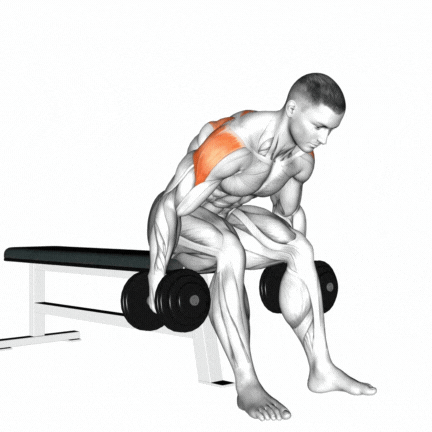
How To Do
- Sit on a bench or chair with your feet firmly planted.
- Hold a dumbbell in each hand with your palms facing inward.
- Lean forward from your hips while maintaining a straight back, allowing your arms to hang down toward the floor.
- Slightly bend your elbows and raise your arms to the sides in a wide arc.
- Continue the movement until your upper arms parallel the floor or slightly higher.
- Then, slowly lower the dumbbells back to their starting position.
Tips
- Keep a controlled motion and avoid jerky movements.
- Start with lighter weights to focus on technique and form.
- Perform the exercise slowly and calmly, emphasizing the eccentric (lowering) phase.
- Exhale as you pull your arms back, and inhale as you come back
Know More: Rear Delt Fly: Muscles Worked, Benefits, Variations
Dumbbell Back Workout Routines (With Tips & Techniques)
Weekly Training Sets For Back
The number of sets will be determined based on your fitness journey, but this is a great starting point.
- Beginners: ~10 sets per week.
- Intermediate: ~15 sets per week.
- Advanced: ~20 sets per week.
When a certain amount of volume stops being effective and your progress stalls, you can add sets to increase volume and use that as a driver of renewed progress.
Optimizing Reps and Weight for Muscle Goals
- For muscle endurance: Aim for 3–4 sets of 12–15 reps, with a moderate amount of resistance.
- For muscle strength: Aim for 3–5 sets of 6–10 reps, with a heavier amount of resistance.
- For muscle hypertrophy (increased muscle size): Aim for 3–4 sets of 8–12 reps, with a moderate to heavy amount of resistance.
It is always best to start with a lower number of reps and sets, and then gradually increase as your strength improves.
Furthermore, it is important to allow for adequate rest between sets, typically 60–90 seconds.
Beginner Dumbbell Back Workout Routine
If you’re new to lifting weights, don’t worry. This beginner-friendly dumbbell back workout routine is a great place to start.
When this becomes easier, you should pick a heavier weight.
After you’ve upped your weight several times and feel strong in the movements below, move on to the intermediate routine. Until then, you can follow this beginner-back workout plan.
| Exercise | Sets | Reps |
|---|---|---|
| Bent Over Dumbbell Rows | 3-4 | 8-10 |
| Upright Row | 3-4 | 8 |
| Renegade Row | 4 | 8-10 |
Intermediate Back Workout
If you are at the intermediate level or have outgrown the beginner routine, try the intermediate back workout routine below.
| Exercise | Sets | Reps |
|---|---|---|
| Dumbbell Deadlift | 4 | 8-10 |
| Dumbbell Bent Over Row | 3-4 | 10-12 |
| Dumbbell Pullover | 4 | AMAP |
| Dumbbell Upright Row | 3 | 8-10 |
Advanced Back Workout
If you are an advanced-level athlete or have already completed the beginner and intermediate dumbbell back workouts, try the advanced routine.
Here, you’ll challenge more of your balance, stability, and strength
| Exercise | Sets | Reps |
|---|---|---|
| Dumbbell Deadlift | 3 | 6-8 |
| Dumbbell Shrug | 3-4 | 10-12 |
| Bent Over Dumbbell Lateral Raise | 4 | 10-12 |
| Renegade Row | 3 | 8-10 |
| Side-Lying Rear Fly | 3 | 8-10 |
Complete the Back Workout With a Dumbbell
Effective back training should incorporate various exercises and target all the major back muscles.
For a complete back workout and to build balanced strength, you’ll need to do various back exercises to specifically target your trapezius, upper, middle and lower back muscles.
- Dumbbell Shrugs and upright rows are great exercises for building trapezius muscles.
- Upper and middle dumbbell back exercises target the middle and lower trap, rhomboids, and lats. When choosing exercises for your upper back, you should include various row exercises, such as dumbbell bent-over and rear delt rows.
- The lower back can be targeted with exercises like deadlift and Renegade Row.
FAQ
To conclude, let’s review some frequently asked questions about training your back with dumbbells.
What Dumbbell Exercises Work The Back?
You must perform various movements from various angles to build a thick, wide, and muscular back.
There are many dumbbell exercises that can be used to train the back muscles. Add the above-mentioned exercises to your back workout regime as per your fitness level.
Is Train Back With Dumbbell Is Effective
Dumbbell back workouts strengthen your back muscles from your traps to your spine.
The movements target your erector spinae, latissimus dorsi, rhomboids, serratus, and trapezius muscles, all involved in achieving your back goals.”
How do you use dumbbells to work your mid back?
Your “mid-back” consists of your lats, traps, and rhomboids. You can do single-arm rows or close-grip dumbbell rows and Incline rows to target your middle back with dumbbells.
How do you use dumbbells to work your lower back?
Your lower back muscles include your erector spinae and lat. You can do Dumbbell deadlifts and variations of deadlifts like RDLs and renegade rows to target your lower back with dumbbells.
Conclusion
The beauty of dumbbell back exercises lies in their versatility and accessibility. No fancy gym membership or complex machines are required. Dumbbells allow you to target specific muscle groups and promote core stability throughout the movement.
These dumbbell back exercises and workout plans are highly recommended for anyone interested in building a wider back and gaining strength. These exercises aren’t just effective; they’re beginner-friendly.
Be smart: Don’t limit yourself to dumbbell exercises. Take advantage of their benefits and supplement them with other back exercises when needed.
Dumbbells can be easily incorporated into any training program and are particularly effective when used alongside barbells, machines, and cables to build the biggest, strongest back possible.
Thank you for reading, I hope you enjoy your dumbbell exercises for the back!
Stay Fit, Live a Happy and Healthy Life

Manish brings over 10 years of hands-on experience in weight lifting and fat loss to fitness coaching. He specializes in gym-based training and has a lot of knowledge about exercise, lifting technique, biomechanics, and more.
Through “Fit Life Regime,” he generously shares the insights he’s gained over a decade in the field. His goal is to equip others with the knowledge to start their own fitness journey.
